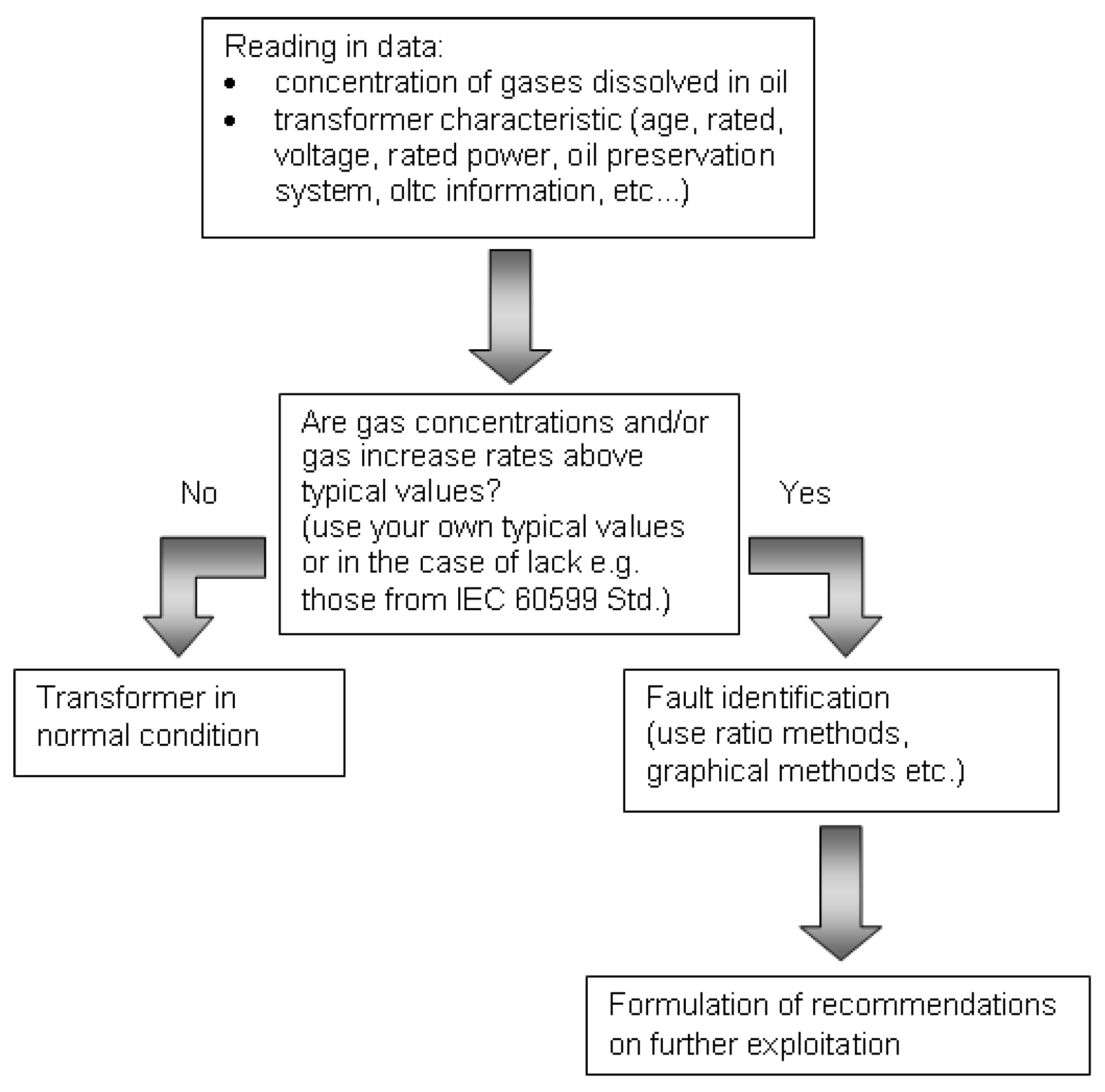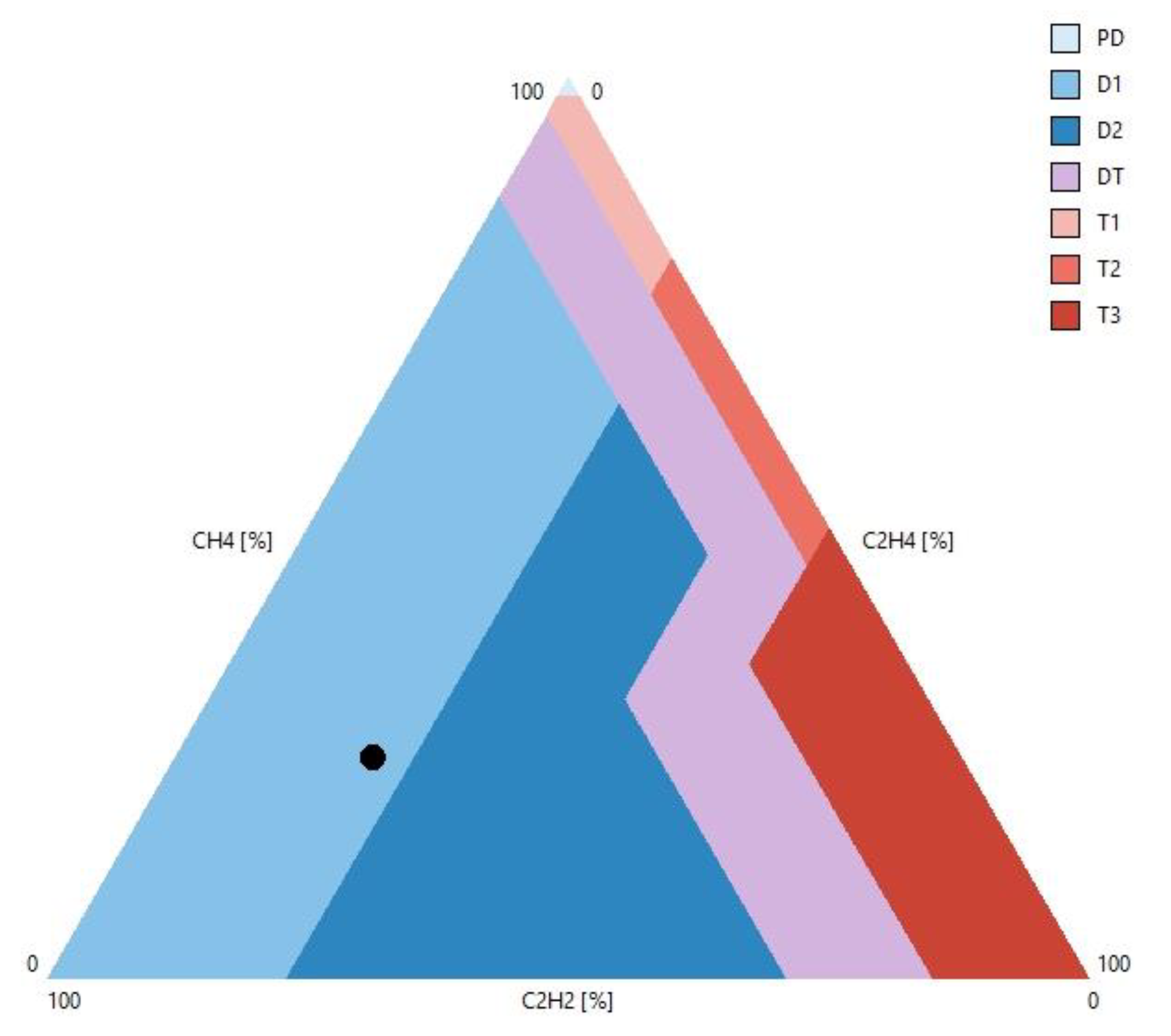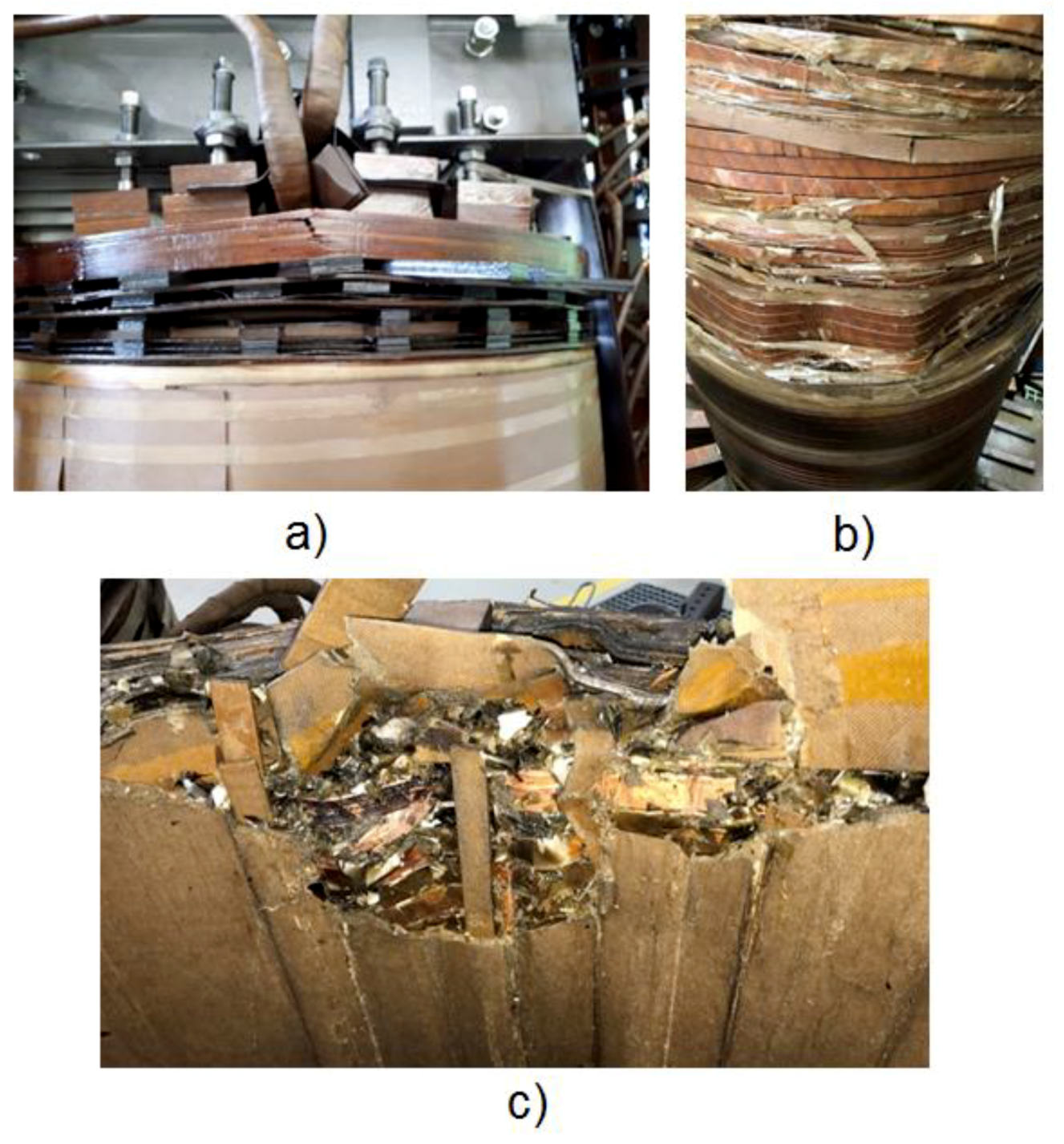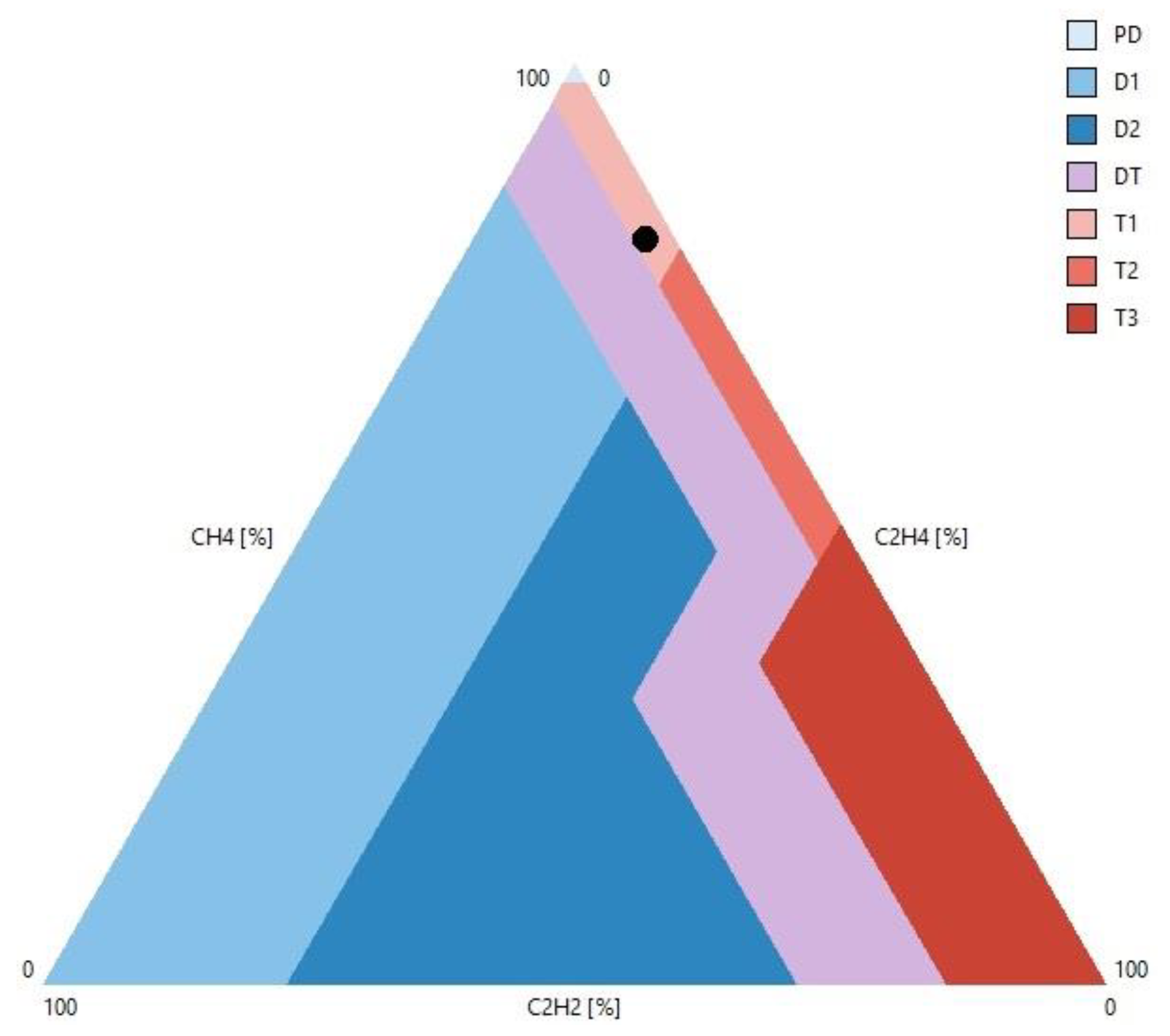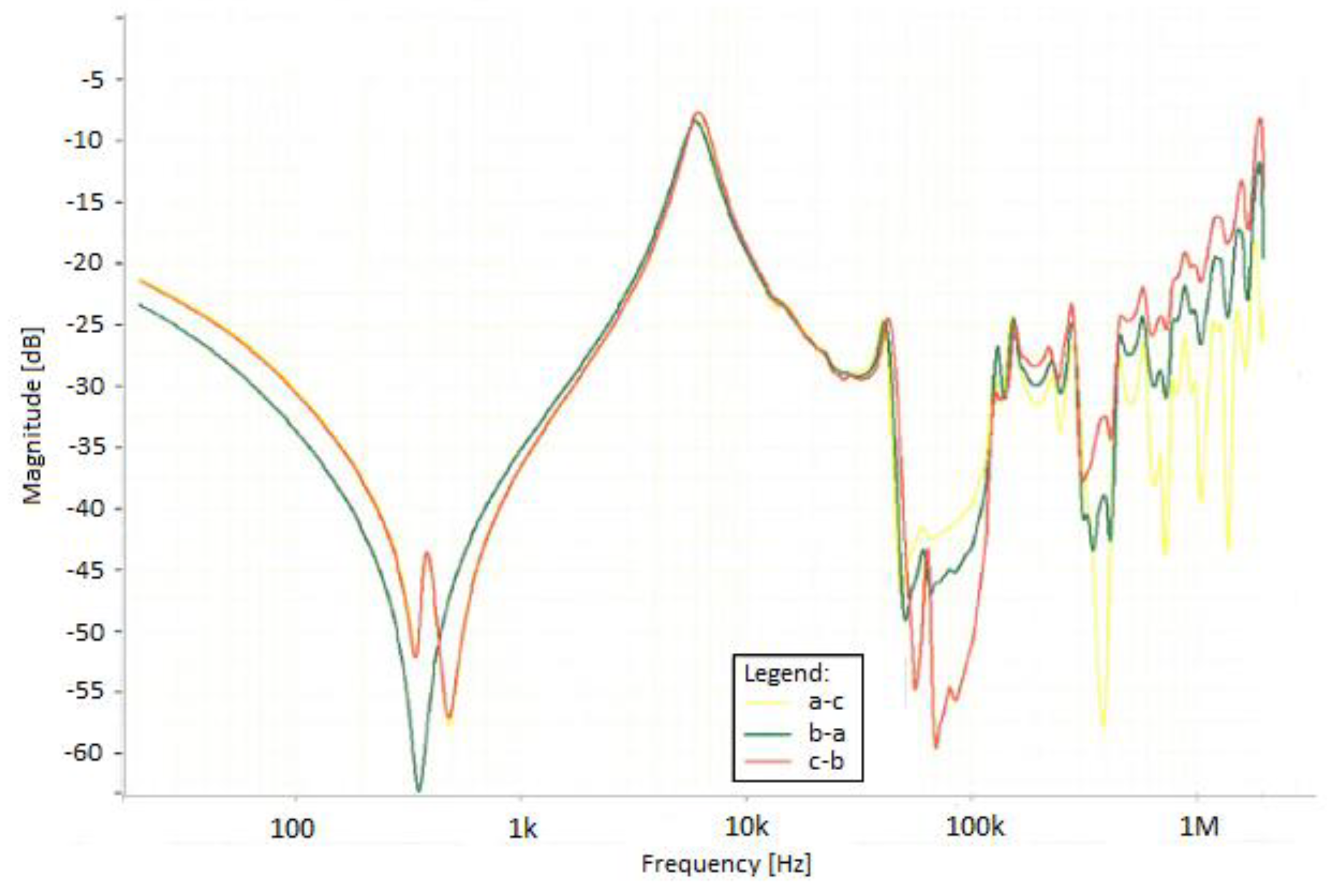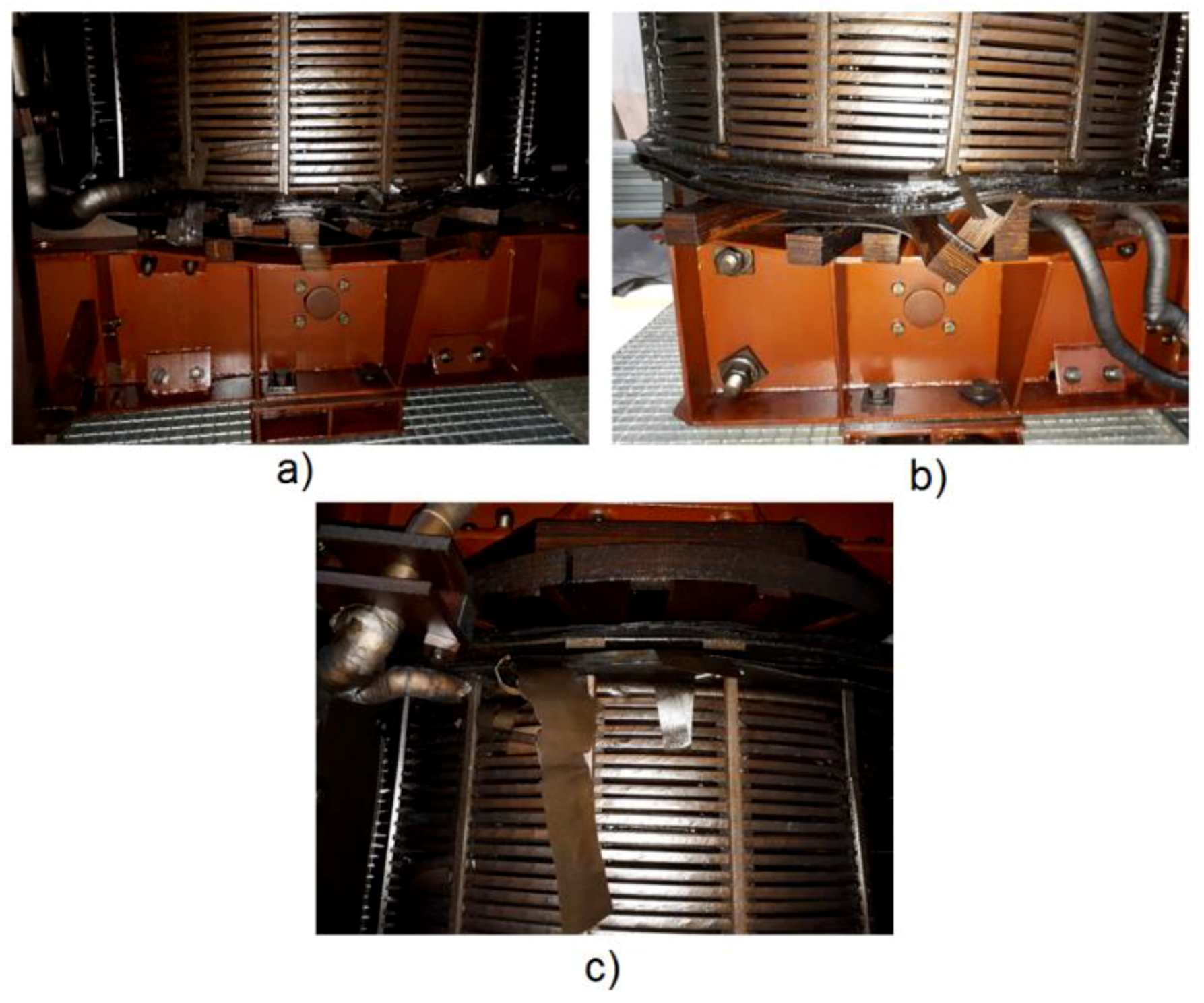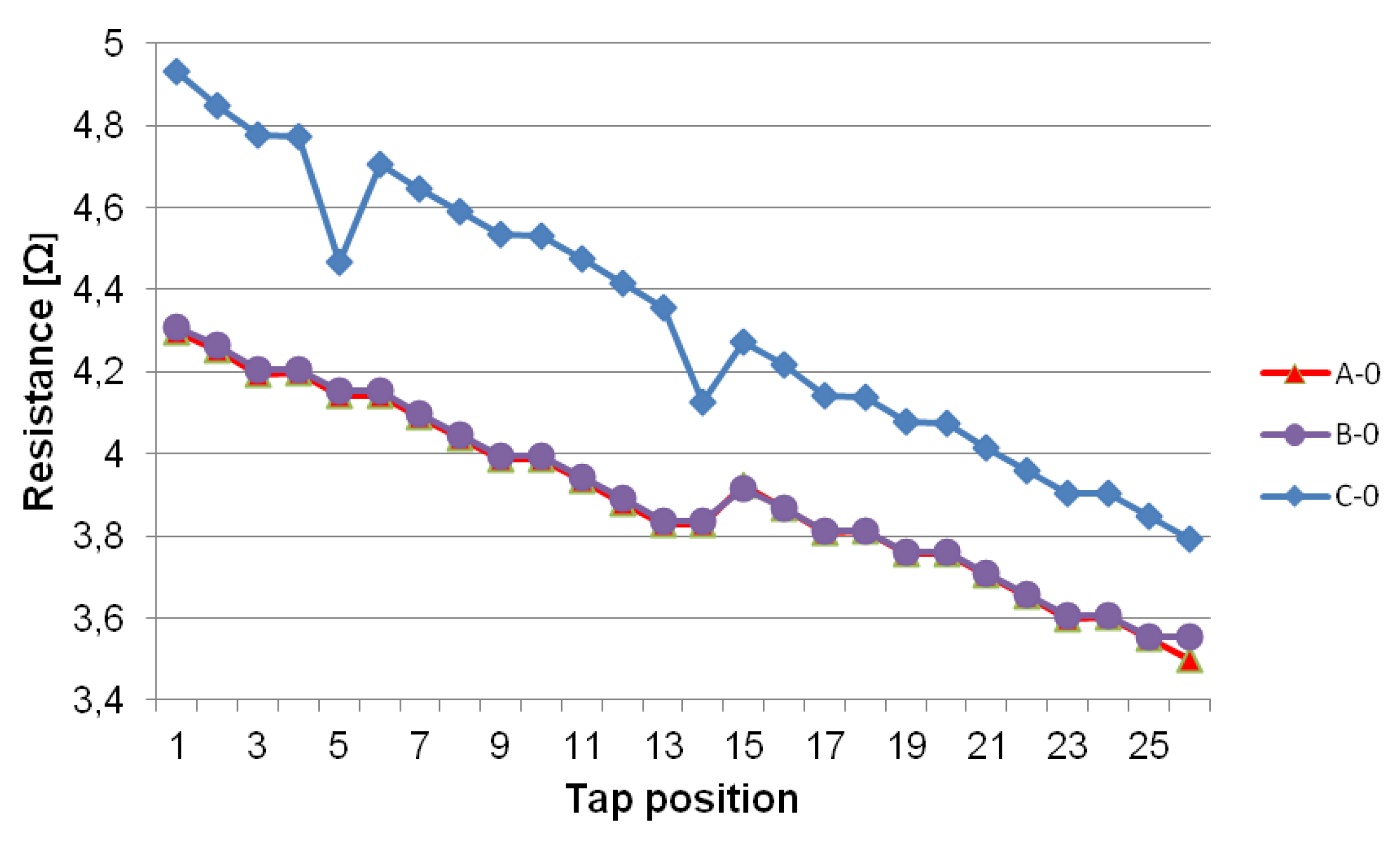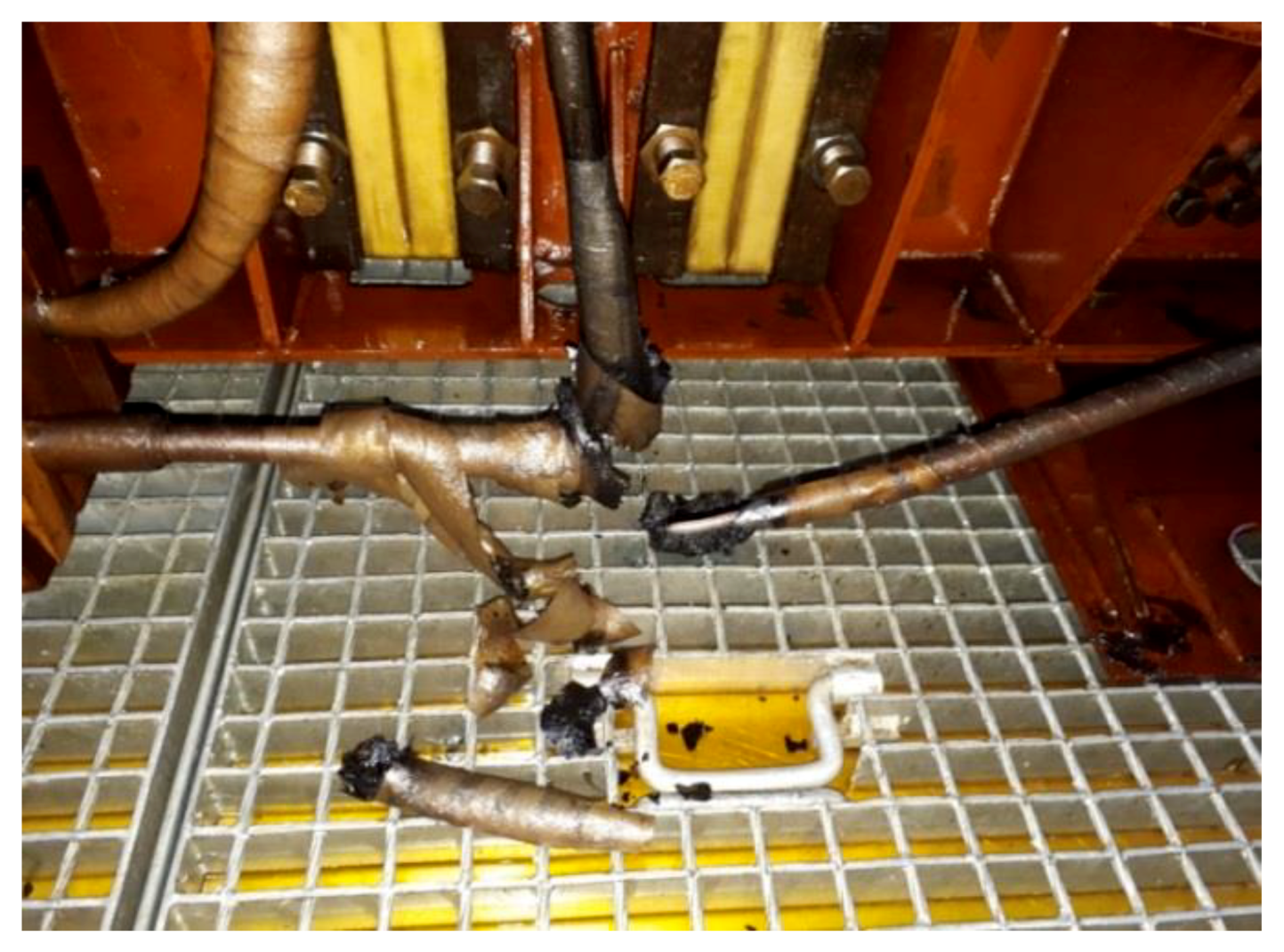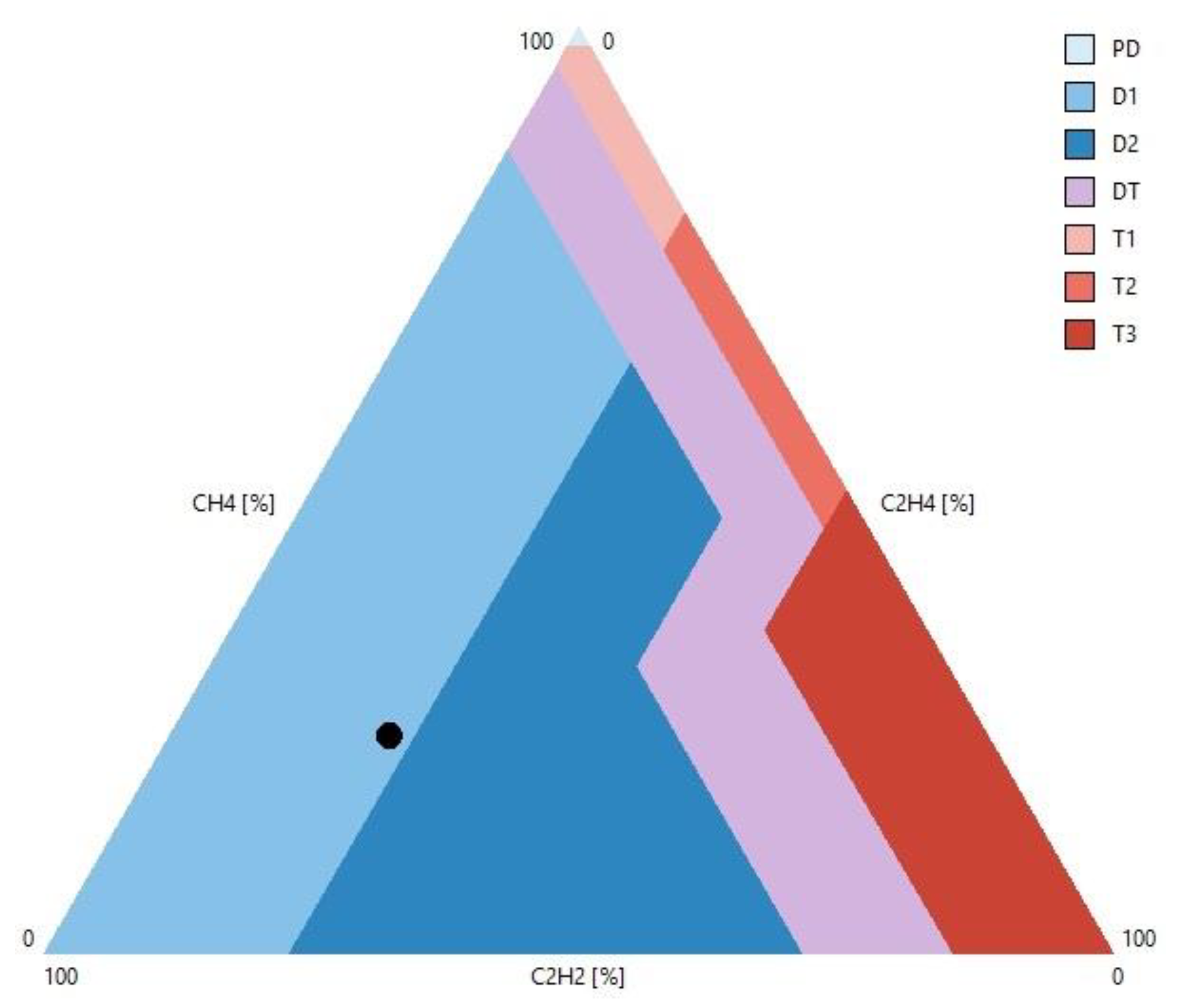1. Introduction
Each unexpected outage of power transformer is associated with financial losses for its owner, as well as the energy consumers who are supplied through this transformer. Additionally, when unsealing the transformer tank, a fire might break out or a leakage of mineral oil (still the dominant insulation and cooling medium in power transformers) might occur, causing soil and water contamination [
1,
2]. Hence, it is important to detect at an early stage, all signals that might indicate a potential defect in a transformer. Then, on the basis of a proper diagnostic procedure, an effective and rational decision for the further exploitation of a given transformer unit might be made up. One of such decisions is timely de-energizing power transformers from service and forwarding it to an internal inspection. It should also be understood that, in addition to the technical condition of the transformer, decision about its de-energizing might be forced by the age of the transformer, its service condition, place of installation, and the ability to replace it by a reserve unit. The proper selection of a diagnostic procedure and correct interpretation of the results obtained from different types of measurements are valid, no matter the place of the transformer installation [
3,
4,
5,
6,
7,
8,
9,
10,
11,
12,
13,
14]. In the case of wind and solar farms, appropriate procedures become even more important due to the accumulation of stresses that affect both the insulation and an active part of transformer. These stresses result, among others, from a high variability of loads, frequent de-energizing of transformers, environmental impact (lightning, large daily fluctuations in ambient temperature, and sea climate), and requirements to stay operational during significant voltage dips [
15]. The analyses carried out have indicated that transformer failures might occur mainly in the insulation system of the transformer, transformer windings, bushings, and on-load tap changers (OLTC). Hence, appropriate methods and diagnostic procedures must be chosen, in order to allow the detection of defects occurring solely in these parts of the transformer. The best option seems to be the use of methods that are non-invasive, easy to apply, and give an intuitive view about the initial selection of transformers on healthy units and units with suspected or developed defect [
5,
10,
16,
17,
18,
19]. Among these methods, one of the most important is the analysis of the gases dissolved in oil (DGA), which constitutes a part of the fundamental measurements within the first level of a diagnostic procedure of a transformer in service [
9]. DGA is a commonly used method that allows for the detection of thermal or electrical defects that occur in oil–paper insulation. The distinctive defects (breakdowns, partial discharges, and thermal faults) might generate a characteristic pattern of gases. Electrical discharges in oil generate large amounts of hydrogen (H
2) and acetylene (C
2H
2). In the case of defects of cellulose insulation, carbon monoxide (CO) and carbon dioxide (CO
2) are also generated. In the case of partial discharges in oil, large quantities of hydrogen and methane (CH
4) are formed. Concerning partial discharges in oil-impregnated cellulose insulation, small amounts of CO and CO
2 might be measured. However, the type and amount of gases generated as a result of the thermal degradation of oil, depend on the temperature. With an increase in temperature, hydrocarbons are generated in the following sequence, methane–ethane–ethylene–acetylene, but H
2 concentration is low in this case. Thermal decomposition of cellulose is associated with the generation of large amounts of carbon monoxide and lesser amounts of carbon dioxide [
4,
5,
9,
13,
16,
17,
18,
19,
20]. The conclusions about the transformer’s technical condition, based on the results of the chromatographic analysis of the oil sample taken from the transformer, is typically carried out in accordance with the general scheme presented in
Figure 1 [
20].
The exceedance of the typically assumed values (the second block from the top) could be used as an indicator in the assessment of the transformer as a unit of normal condition or one suspected of defects. However, it is important to point out that the differences might be a result of the methods applied for determining the nature of the defect. This is especially apparent when the availability of historical measurement data is limited [
9,
16,
17,
18,
21].
In Poland, the typical values of gas concentrations in oil are described separately for the generator step-up and the network power transformers [
16]. These are listed in
Table 1.
Acceptable gas concentration increase refers to the total amount of combustible gases. For the generator step-up power transformers and the network power transformers, these are 35 ppm/month and 40 ppm/month, respectively. The level of defect development is evaluated on the basis of the sum of combustible gases. It is assumed that in the case of generator step-up transformers, a slowly-developing defect evolves when the mentioned sum is in the range of 2200–3700 ppm, while for the network transformers, this sum is between 2500 and 3700 ppm. However danger state occurs, when the sum of combustible gases, independent of the transformer type, is in the range of 3700 and 7500 ppm and is in an emergency state, when the sum exceeds 7500 ppm. The character of the defect is determined on the basis of the ratio method recommended by the IEC (International Electrotechnical Commission) 60599 Standard [
22]. The distinctive limits describing the type of defect are set as a reminder in
Table 2.
Additionally, the determined value of CO
2/CO ratio, which is lower than 3, might indicate that cellulose insulation is a subject of abnormal decomposition (fault involves cellulose insulation). In the case of the defect of a thermal origin, the criteria quoted in
Table 3 are used for determining the overheating temperature [
16]. For obtaining a diagnosis or when one cannot be obtained from the ratio method based on the IEC 60599 Standard, the Duval Triangle Method is applied (the triangles are called 1, 4, and 5) [
18,
23].
A quantity considered in the assessment of the technical condition of transformers is the winding resistance measurement, which belongs to the fundamental electrical measurements and is performed typically when the first level of diagnostic procedure gives information of the potential defect [
9]. It is carried out for the de-energized transformer and with the terminals disconnected from the network. Winding resistance is measured between all line terminals of transformers, both at a high voltage (HV) and a medium voltage (MV) or low voltage (LV) site [
16,
24,
25]. An important aspect is that the measured and calculated values of resistances must be given in relation to the reference temperature, which commonly equals to 20 °C. So, if they are measured in another value of temperature, they must be recalculated with simultaneous consideration of the materials of the windings (cooper or aluminum). According to the recommendation of [
25], the values of the resistances should not differ by more than 1% from the values given by the transformer manufacturer. In turn, the differences between the resistances corresponding to the distinctive phases, should not be higher than 3%. The measurements of the resistances between the external terminals of the transformer, allow for detection of gaps between the contacts, short circuits, or the conditions of the mechanical and welded connections. These problems might concern the windings and bushings, as well as the de-energized tap changers (DETC) and the on-load tap changers (OLTC). This is because all of these components affect the measured values of resistances. The measurement of winding resistance might be helpful in determining the place of failure, when the dissolved gas analysis indicate local overheating.
Together with the winding resistance measurement, the method of sweep frequency response analysis (SFRA) is widely applied in the diagnostic procedures, when the DGA results (as well as other oil parameters) give information about the suspected defect. The SFRA method is based on applying the frequency modulated AC voltage to one of the terminals of the transformer and performing the measurements of voltage/current (typically voltage) occurring on another transformer terminal. For diagnostic purposes, both amplitude-based observations and angle-based observations in terms of the transfer function in a given range of frequency are used. In practice, the amplitude-based observation is commonly applied [
25,
26,
27,
28,
29,
30,
31,
32]. According to [
16,
27] as a useful range of frequencies from the diagnostic point-of-view, the following ranges might be quoted−5 kHz ÷ 1 MHz for power transformers of a rated voltage >100 kV and 5 kHz ÷ 2 MHz for power transformers of a rated voltage <100 kV. The frequencies above 1–2 MHz and below 5 kHz are not used in practical applications of the SFRA method because for frequencies f < 5 kHz, the magnetic residue in the core makes the interpretation of results difficult, and for frequency f > 1–2 MHz, problems with repeatability of the results might appear. The measurements are commonly performed for the windings of each side in typical connection systems—open, short-circuited, with capacitive coupling, and inductive coupling. For each of these systems, the shape of the transfer function is different. The studies carried out till date and experiences from interpreting the results [
28,
29,
30,
31,
32] have showed that the shape of the transfer function in some ranges of frequencies, might be connected with the given types of defects. These defects have been defined below by taking into account that the frequency limits have not been defined precisely:
for f < 20 kHz—residual magnetism, problems with core, open circuits, shorted turns,
for 20 kHz < f < 100 kHz—bulk winding movement,
for 100 kHz < f < 500 kHz—radial and axial winding deformation,
for f > 500 kHz—taps leads, measurement leads, winding connections.
In general, SFRA is a method of comparative character, which means that the actual shape of the transfer function is related to the results obtained in the previous measurement, for the same winding of the same transformer, the measurements performed for other windings of the same transformer, or the measurements carried out for the sister units. For this reason, extensive experience in interpreting the observed transfer functions is required. Additionally, the SFRA measurements are burdened with a large degree of subjectivity of assessment. Attempts have been undertaken for an elaboration of objective criteria and indicators that underline the importance of the changes, but so far these attempts have not been successful.
Taking into account the description presented above, in this paper the authors have decided to present the results of practical use of the mentioned diagnostic measurements in assessment of the technical conditions of the transformers in service, in the form of case studies. The case studies described were specially selected as they represent the situations when availability of historical data about the previous measurements was limited and a quick diagnosis had to be made on the basis of the results from the last measurements. Such situations occur quite often, when the transformer units are taken over from a given management company, without any operating documentation. In such a scenario, the latest measurements are decisive and decisions about diagnostic actions are made on the basis of their results. In the second case only the most recent measurements were considered in the diagnostic procedure as the previous measurements were obtained from different diagnostic companies and were performed by different measurement instruments. This is a common situation in Poland because a transformer management company, due to the applicable law, is obligated to choose a company that performs the measurements on the basis of auction, as a result there is a high frequency of change in companies. Considering this state of affairs, having a diagnostic procedure becomes difficult, as it is a known fact that the differences appear in the results obtained from the measurements made by different laboratories [
21]. Additionally, all case studies presented concerned situations where after diagnostic procedure the transformer units were withdrawn from service and directed to the internal inspection. The emphasis was placed on the presentation of the technical reasons that led to such a decision. Then, these reasons were set with the defects identified and the reasonableness of the decision taken was assessed.
The case studies were also chosen from the point-of-view of their importance for researchers, considering the condition monitoring and diagnosis of the transformers in service and the scientists who developed the diagnostic methods that were especially based on DGA.
However, existing methods that recognize the nature of the defect occurring in transformers, on the basis of measured concentrations of gases dissolved in oil have been developed as a result of the analysis of a large number of data derived from real transformer units, or that obtained during experiments carried out in the laboratories where oil is subjected to specific thermal or electrical stresses. An example of a database that was used to develop new diagnostic methods is provided in [
33]. In turn, the method of using the sets of gas concentrations dissolved in oil to develop a diagnostic tool is presented in [
34]. Thus, the case studies presented, herein, might interest scientists planning the development of methods for interpreting the concentrations of gases dissolved in oil or supplementing the databases with new case studies, where a defect identified on the basis of DGA (using the IEC 60599 Standard and the Duval Triangle Method) has been confirmed by internal inspection.
On the other hand, the presented case studies are important due to the fact that they showed a mutual complementation of various diagnostic methods that required the withdrawal of the transformer from service (such as with the DGA method) with ones that did not require such a withdrawal. Thus, these case studies might be interesting for practitioners who want to confirm the type of damage reported by the DGA.
The presented cases were also consistent due to the fact that the DGA results solely indicated the need to precisely analyze those units in which a certain type of defect might have occurred.
Finally, the data provided herein might also be used later to verify the effectiveness of the diagnostic methods or to develop the computer tools made for interpreting the diagnostic results, e.g., in the process of training and validation of artificial neural networks.
3. Discussion
The case studies presented in the paper concerned oil-filled power transformers of various nominal voltage and power, their different constructional features, and the different functions they performed in the power system. The transformers were also characterized by different operating time. Despite these differences, the first signal indicating a defect was always obtained as a result of the oil tests, and in particular as a result of information about the gases dissolved in oil. However, in each case, the identified defect differed from the others.
The first case study revealed the weakness of the analysis of gases dissolved in oil—the failure of the analyzed transformer might have occurred between the consecutive oil tests. However, this fact was not a surprise. Such a disadvantage also characterized all operation actions performed at the scheduled time intervals (so-called time-based maintenance). The solution to this problem was the use of continuous monitoring of the selected diagnostic indicators, among which the concentrations of the gases dissolved in oil was treated as one of the most important indicators. In the case of an electrical discharge, which is usually a sudden phenomenon caused by external factors, a continuous monitoring might also be insufficient.
In the literature, it is difficult to find a description of the defects that are indicated by an analysis of the gases dissolved in oil and the SFRA methods, with a simultaneous absence of signals from other diagnostic methods. Therefore, an analysis of case Study 2 should have been interesting. Deformation of the windings detected by the SFRA method could have been a cause of disturbance in the flow of the cooling agent (mineral oil) and could have been a source of local overheating, which in turn was indicated by the DGA results.
The third considered case study showed a good complementation of the DGA method and the measurements of the winding resistance. DGA as a method that does not require turning off the transformer from the service, indicated the nature of the defect. However, performing the winding resistance measurement—a method requiring the transformer to be turned off—was used to identify which transformer element was responsible for the observed thermal defect.
The last of the presented cases indicated that the observation of anomalies in the gas concentrations and detection of their cause during the internal inspection of the transformer would facilitate the elimination of similar constructional errors, in the entire group of transformers originating from a single manufacturer. In this case, after detecting a similar pattern for the gases dissolved in the oil, it was possible to locate the source of gas generation through an analogy to the inspected unit. This allowed for the omission of tedious searches.
In conclusion, all presented cases were combined through a common point—the nature of defect occurring in the transformers was recognized on the basis of measured concentrations of gases dissolved in oil. The IEC 60599 Standard based analysis, as well as the Duval Triangle Method jointly indicated a similar type of defect on the basis of the data available from the latest measurements. As we also had other measurement data, such as SFRA or a winding resistance measurement, the decision process was carried out and an internal inspection was performed. In all cases, the defect identified on the basis of DGA was confirmed by this inspection. Thus, the case studies presented in this paper represent important data which might be used by the scientists who develop diagnostic methods or expert systems, based on DGA. The results presented might also supplement the databases of the expert systems where identification of the defect resulted from a comparison of cases of a similar origin.
